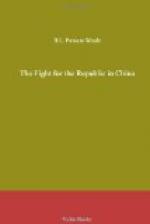As we are now able to see very clearly, fifty years ago—that is at the time of the Taiping Rebellion—the old power and spell of the National Capital as a military centre had really vanished. Though in ancient days horsemen armed with bows and lances could sweep like a tornado over the land, levelling everything save the walled cities, in the Nineteenth Century such methods had become impossible. Mongolia and Manchuria had also ceased to be inexhaustible reservoirs of warlike men; the more adjacent portions had become commercialized; whilst the outer regions had sunk to depopulated graziers’ lands. The Government, after the collapse of the Rebellion, being greatly impoverished, had openly fallen to balancing province against province and personality against personality, hoping that by some means it would be able to regain its prestige and a portion of its former wealth. Taking down the ledgers containing the lists of provincial contributions, the mandarins of Peking completely revised every schedule, redistributed every weight, and saw to it that the matricular levies should fall in such a way as to be crushing. The new taxation, likin, which, like the income-tax in England, is in origin purely a war-tax, by gripping inter-provincial commerce by the throat and rudely controlling it by the barrier-system, was suddenly disclosed as a new and excellent way of making felt the menaced sovereignty of the Manchus; and though the system was plainly a two-edged weapon, the first edge to cut was the Imperial edge; that is largely why for several decades after the Taipings China was relatively quiet.
Time was also giving birth to another important development— important in the sense that it was to prove finally decisive. It would have been impossible for Peking, unless men of outstanding genius had been living, to have foreseen that not only had the real bases of government now become entirely economic control, but that the very moment that control faltered the central government of China would openly and absolutely cease to be any government at all. Modern commercialism, already invading China at many points through the medium of the treaty-ports, was a force which in the long run could not be denied. Every year that passed tended to emphasize the fact that modern conditions were cutting Peking more and more adrift from the real centres of power—the economic centres which, with the single exception of Tientsin, lie from 800 to 1,500 miles away. It was these centres that were developing revolutionary ideas—i. e., ideas at variance with the Socio-economic principles on which the old Chinese commonwealth had been slowly built up, and which foreign dynasties such as the Mongol and the Manchu had never touched. The Government of the post-Taiping period still imagined that by making their hands lie more heavily than ever on the people and by tightening the taxation control—not by true creative work—they could rehabilitate themselves.




